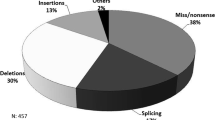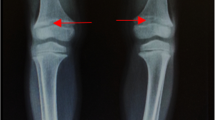Summary
This paper presents three markers, 16D/E, pHMAI (DXS208), and CRI-L1391 (DXS274), that show close linkage for X-linked hypophosphataemic rickets (HYP). DXS274 is closely linked to HYP (θ max= 0.00, Zmax = 4.20), and DXS41 (99.6), (θ max= 0.00, Zmax = 5.20). Marker 16D/E maps distal to the disease locus (θ max= 0.05, Zmax = 3.11). The pHMAI probe recognises the same restriction fragment length polymorphism (RFLP) as 99.6. Multipoint analysis suggests that the most probable order of loci is Xpter-(DXS43, 16D/E)-HYP-DXS274-(DXS208, DXS41)-Xcen. The location of DXS274 distal to HYP cannot be excluded, as no recombinants were observed between DXS274 and HYP, or between DXS274 and DXS41/DXS208. One of the families contains a large number of recombinants, four of which are double recombinants. This most probably means that the disease in this family maps elsewhere on the X chromosome or on an autosome, indicating locus heterogeneity.
Similar content being viewed by others
References
Alitalo T, Kruse TA, Ahrens P, Albertsen HM, Chapelle A de la (1991) Genetic mapping of 12 marker loci in the Xp22. 3-p21. 3 region. Hum Genet 86:599–603
Alitalo T, Kruse TA, Chapelle Ade la (1991) Refined localisation of the gene causing X-linked retinoschisis. Genomics 9:505–510
Barker DF, Speer MC, Pericak-Vance MA, Fain P, Drezner MK (1990) Multilocus mapping of the human X-linked hypophosphataemic rickets gene locus (abstract). J Bone Miner Res 5[Suppl 2]:S108
Cowgill LD, Goldfarlb S, Lau K, Slatopolsky E, Agus ES (1979) Evidence for an intrinsic renal tubular defect in mice with genetic hypophosphataemic rickets. J Clin Invest 63:1203–1210
Dahl N, Goonewardena P, Chotai J, Anvret M, Petterson U (1988) DNA linkage analysis of X-linked retinoschisis. Hum Genet 78:228–232
Davies M, Stanbury SW (1981) The rheumatic manifestations of metabolic bone disease. Clin Rheum Dis 7:595–646
Donis-Keller H, Green P, Helms C, Cartinhour S, Weiffenbach B, Stephens K, Keith TP, Bowden DW, Smith DR, Lander ES, Botstein D, Akots G, Rediker KS, Gravius T, Brown VA, Rising MB, Parker C, Powers JA, Watt DE, Kaufmann ER, Bricker A, Phipps P, Muller-Kahle H, Fulton TR, Ng S, Schumm JW, Braman JC, Knowlton RG, Barker DF, Crooks SM, Lincoln SE, Daly MJ, Abrahamson J (1987) A genetic linkage map of the human genome. Cell 51:319–337
Econs MJ, Pericak-Vance MA, Betz H, Bartlett RJ, Speer MC, Drezner MK (1990) The human glycine receptor: a new probe that is linked to the hypophosphataemic rickets gene. Genomics 7:439–441
Lathrop GM, Lalouel JM (1984) Easy calculation of lod scores and genetic risks on small computers. Am J Hum Genet 36:460–465
Machler M, Frey D, Gal D, Orth U, Weinker TF, Fanconi A, Schmid W (1986) X-linked dominant hypophosphataemia is closely linked to DNA markers DXS41 and DXS43 at Xp22. Hum Genet 73:271–275
Mandel JL, Willard HF, Nussbaum RL, Romeo G, Puch JM, Davies KE (1989) X-chromosome reports. Cytogenet Cell Genet 51:384–437
McKusick VA (1990) Mendelian inheritance in man, 9th edn. Johns Hopkins University Press, Baltimore
Meyer RAJr, Meyer MH, Gray RW (1989) Parabiosis suggests a humoral factor is involved in X-linked hypophosphataemia in mice. J Bone Miner Res 4:493–500
Pascoe L, Morton NE (1987) The use of map functions in multipoint mapping. Am J Hum Genet 40:174–183
Read AP, Thakker RV, Davies KE, Mountford RC, Brenton DP, Davies M, Glorieux F, Harris R, Hendy GN, King A, McGlade S, Peacock CJ, Smith R, O'Riordan JLH (1986) Mapping of human X-linked hypophosphataemic rickets by multilocus linkage analysis. Hum Genet 73:267–270
Tenenhouse HS, Scriver CR, McInnes RR, Glorieux FH (1978) Renal handling of phosphate in vivo and in vitro by the X- linked hypophosphatemic male mouse; evidence for a defect in the brush border membrane. Kidney Int 14:236–244
Thakker RV, Read AP, Davies KE, Whyte MP, Weksberg R, Glorieux F, Davies M, Mountford R, Harris R, King A, Kim GS, Fraser D, Kooh SW, O'Riordan JLH (1987) Bridging markers defining the map position of X linked hypophosphataemic rickets. J Med Genet 24:756–760
Thakker RV, Davies KE, Read AP, Tippet P, Wooding C, Flint T, Woods S, Kruse TA, Whyte MP, O'Riordan JLH (1990) Linkage analysis of two cloned DNA sequences, DXS197 ands DXS207, in hypophosphataemic rickets families. Genomics 8:189–193
Author information
Authors and Affiliations
Rights and permissions
About this article
Cite this article
Rowe, P.S.N., Read, A.P., Mountford, R. et al. Three DNA markers for hypophosphataemic rickets. Hum Genet 89, 539–542 (1992). https://doi.org/10.1007/BF00219180
Received:
Revised:
Issue Date:
DOI: https://doi.org/10.1007/BF00219180




